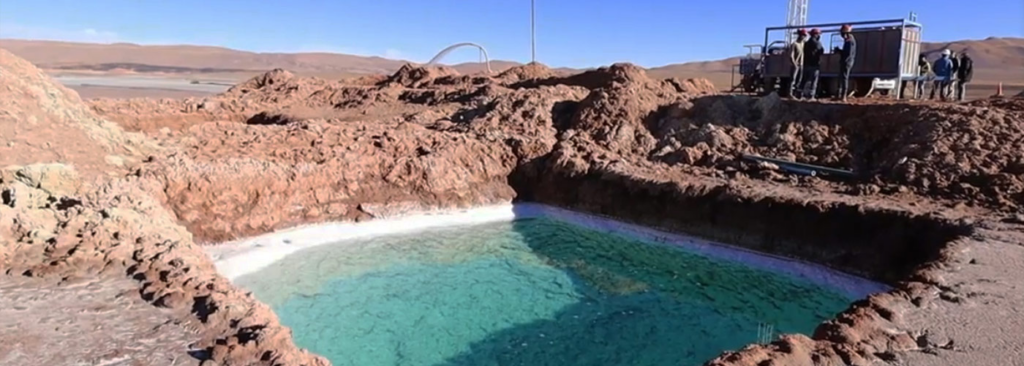
June 15, 2023 / Vancouver, BC / Lithium South Development Corporation (the “Company”) (TSX-V: LIS) (OTCQB: LISMF) (Frankfurt OGPQ) is providing an update on the recently completed exploration program and status of the updated Mineral Resource Estimate that is currently underway for the Hombre Muerto North Lithium Project (HMN Li Project) in Salta Province, Argentina. All core samples have been submitted to GeoSystems Analysis Inc. (GSA), in Tucson, Arizona for porosity analysis. Initial results have been received and all remaining results are anticipated by mid-July. Shortly thereafter, the resource update process will be completed by the brine resource specialist team of Groundwater Insight, Inc. (Halifax Canada), and Aqua Insight Inc., led by Qualified Person, Dr. Mark King.
Work by GSA will determine the bulk density, total porosity, and specific yield (or drainable porosity) of each sample. Specific yield is the ratio of the volume of water a rock or soil will yield by gravity drainage to the bulk volume of the rock or soil. This value is used as a fractional multiplier, to estimate the volume of brine that could potentially drain from a geologic material. In other words, specific yield data for each lithological unit is one of the key parameters (along with lithium grade) used to estimate lithium brine resources.
Initial results from 18 core samples indicate that the brine within the Alba Sabrina units is potentially drainable, with specific yields ranging from 8.9% to 38.6%. This first set of samples represents partial results for the upper and lower sedimentary units, and one result for the brecciated quartzite. Similar specific yield results are expected from the remaining Alba Sabrina and Natalia Maria samples based on lithological observations.
In comparison, Tramo specific yield results previously reported in the 2018 Mineral Resource Estimate (September 7, 2018) ranged from 2.6% to 24.6%. Average specific yield based on a limited re-interpretation of Tramo lithologies (as part of the development of a basin-wide geological model) is as follows:
- Interlayered clastic sediments: 9.0%
- Interbedded halite and sediments: 10.0%
- Conglomerate: 8.7%
Results for 62 core samples from the recent exploration program are still outstanding. It is anticipated that disaggregated results will require adjustment, and that some samples may not be testable, due to the unconsolidated nature of the material. Results will be reviewed in parallel with lithological observations and photographs and anomalously high specific yield results related to unconsolidated samples may be adjusted to account for handling of loose materials.
Groundwater Insight Inc. is currently preparing the updated Mineral Resource Estimate for the Alba Sabrina, Natalia Maria, and Tramo properties. The geological model is complete and analytical results from GSA are the last piece of information required to finalize the Resource Estimate.
Geological Setting
Recently completed drilling on the Alba Sabrina and Natalia Maria properties intersected diverse lithological units in each project area, highlighting the regional variability of salar deposits within Salar del Hombre Muerto. The geology on each property is distinct, and also distinct from the Tramo property, which was the focus of the 2018 maiden Resource Estimate. The attached figure shows the property configuration, the dominant landforms in the area (especially the Tincalayu Peninsula) and grade results.
Alba Sabrina encompasses a channel in the northwest sector of Salar del Hombre Muerto, formed by the Tincalayu Peninsula. This semi-isolated salar channel is clastic-dominated, with no halite intersected by drilling. In this channel, the bottom of the salar basin is demarcated by unaltered, low permeability quartzite. This unit is overlain by up to 150 m of altered, fractured to brecciated quartzite with high secondary porosity.
The overlying clastic salar units range from coarse grained sands to interlayered clays. These units range from unconsolidated to compact and consolidated. A basalt layer separates the upper and lower sedimentary packages on the eastern side of Alba Sabrina and extends into the central part of the channel. The basalt is characterized by multiple flows with highly vesicular, amygdaloidal, and massive horizons and minor to pervasive fracturing. It is considered to correlate with basalts on the adjacent Tincalayu Peninsula, but has undergone downward displacement, followed by deposition of overlying salar materials.
The Natalia Maria property represents a halite-dominated area of Salar del Hombre Muerto, on the eastern margin of Tincalayu Peninsula. Lithology intersected during drilling includes an upper 50 m package of interlayered sediments that correlate to the shallow sedimentary deposits observed at Alba Sabrina and Tramo. A crystalline halite with occasional sandy halite or medium to coarse grained sand layers occurs below 50 m and grades to massive halite at approximately 200 m. This unit was not encountered at the Tramo property further to the east, and its full extent is not known.
Tramo is in the clastic-dominated northeastern zone of the Salar del Hombre Muerto. Tramo lithology is a combination of the other Project areas with an upper interlayered clastic sediment unit and an interbedded halite and sediment sequence. The eastern half of the property also hosts a lower polymictic conglomerate. Additional third-party drilling results were also used to inform the geological model developed for the salar basin.
About Lithium South
Lithium South is focused on developing the Hombre Muerto North Lithium Project (HMN Li Project) on the Hombre Muerto Salar, a major lithium-producing salar in Argentina. The salar is currently undergoing significant lithium project development by Korean giant POSCO, and the newly announced Allkem/Livent combination. Billions of dollars are planned to be invested in the area to build out lithium production on one of the best salars in the Lithium Triangle. Lithium South is in an excellent position to participate in this significant area development.
Source
![LOGO [återskapat] LOGO [återskapat]](https://batteryjuniors.com/wp-content/uploads/elementor/thumbs/LOGO-återskapat-ozpr6tyjh3va1ifcopltktksqownqc64mplxytts9k.png)
